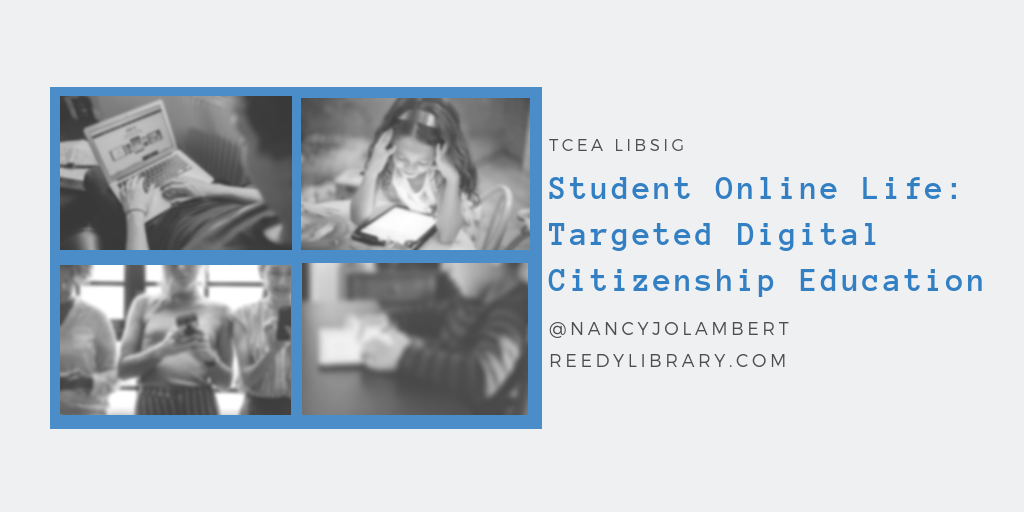It’s almost Digital Citizenship Week. While it’s great to bring awareness to the importance of digital citizenship this week, five days is not enough. That’s why I’m outlining the areas of digital citizenship that need dedicated attention and purposeful planning by librarians, teachers, and administrators.
Librarians Lead the Way in Information Literacy
Current librarian digital citizenship practice is about helping our students use online content in responsible ways. We should be teaching our students that you cannot just use anything you want from the internet in any way that you want. We should be communicating to our teachers that we can help them when their assignments involve students using information or images from the web. For every assignment, librarians should be demonstrating how to find, evaluate, and use information from credible sources. We should be talking about copyright and how to use citations to give attribution. This important digital citizenship skill set is often overlooked by administrators and teachers because it is easy to put on the back burner and also because librarians are not making these lessons and resources readily available in the curriculum. The bottom line is we should be inserting ourselves into every lesson, every project, every essay, and every assignment where students are asked to do anything with the information.
Modeling Good Behavior
We all know that the online world is changing and shifting at a rapid pace. Often, as educators, we aren’t fully aware of what our students are really doing online. I know I am not a gamer, so the world of online gaming is something I am aware of, but don’t participate in. I am also not an avid YouTuber. I don’t watch a lot of YouTube for pleasure, nor do I subscribe to popular YouTuber channels. I give these two examples to explain that even though we have to teach digital citizenship, we may not completely understand the online communities and environments our students are spending a significant amount of time in.
The responsibility of helping kids be good digital citizens often falls to parents. Parents, after all, are the ones who are supposed to control what devices, games, and social media accounts their children have access to. Kids now know they can create multiple accounts for almost any online service, and some go as far as acquiring a trap phone (usually a second phone kids use without their parents’ knowledge that has WiFi capability only). Parents are often not in the know about the extent of what their kids are doing online.
Modeling appropriate online behaviors and educating students about what it means to be a good digital citizen is becoming increasingly important. I talk to students all the time about their online reputation. A quick and easy Google search can reveal a great deal about a person. I try to help my students understand that something their 15-year-old self finds funny or appropriate to post or share online might not be something their 30-year-old self appreciates. This is especially true if it costs them a job or opportunity. I ask my students to think about showing their online life to a respected family member or someone they might want to marry. Would they be proud of everything that shows up?
Resources for Teaching Digital Citizenship
At the start of the school year, I always do a digital citizenship lesson with my Career and Technology classes. This year, I revamped some outdated content my school had been using. With the help of my Digital Learning Coach, we created a Google Site to house the content and paired the eight “stations” of content with GooseChase missions. After the students successfully completed the missions, they were given an access code for a Google Quiz that I made to accompany the stations which I dropped into each teacher’s Google Classroom. Here is a Google Folder I made with copies of content and other resources for this activity. I want to encourage other librarians to create and share the content we use to teach and model digital citizenship!
Our students are growing up in a completely digital world. Their entire lives, often from birth, are documented online through social media, images, videos, and online profiles. We have to help them understand this fact and recognize that what goes online, stays online – forever! We should be talking about digital citizenship issues in every school, every day, and with students of all ages.
This is a guest blog by Nancy Jo Lambert as part of a monthly series of blogs from LIB-SIG. Nancy Jo is a high school teacher librarian at Reedy High School in Frisco ISD. She is a presenter and speaker who advocates for libraries by telling the story of the learning happening in her library. She holds positions in the Texas Library Association and in TCEA. She also has committee appointments in the American Library Association, American Association of School Librarians, and the Texas Association of School Librarians. She has been published in professional journals and has won numerous awards and grants. Nancy Jo is also a Google Level 1 and Level 2 certified Educator. She is known for her sharing her professional work on her library website: http://www.reedylibrary.com.


1 comment
Citizenship Education is very important, it helps them to develop self-confidence and a sense of agency, and successfully deal with life changes and challenges such as bullying and discrimination. It gives them a voice: in the life of their schools, their communities, and society at large. To know more about Citizenship Education visit Desh Apnayen. Desh Apnayen is a movement that aims to build an accountable citizenry and society around three important themes: citizenship education, volunteerism, and neighborhood.